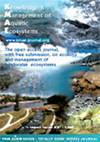南高加索国家、亚美尼亚、阿塞拜疆和格鲁吉亚的第一个非本地鱼类的统一清单
IF 1.7
3区 环境科学与生态学
Q3 FISHERIES
引用次数: 7
摘要
南高加索(SC)地区以其高度的生物多样性和各种地方性动物分类群而闻名。多年来,该地区经历了许多鱼类引进,但没有关于三个SC国家(亚美尼亚、阿塞拜疆和格鲁吉亚)非本地鱼类的总体信息。虽然这三个国家属于里海盆地库拉河流域(格鲁吉亚只有西半部流入黑海),但每个国家关于引进非本地鱼类及其待遇的立法框架不同且不发达。本研究的目的是对三个南太平洋国家的非本地鱼类物种进行初步清查,并总结现有知识,作为未来风险评估模型和制定区域管理政策的基础。在这里,我们列出了在亚美尼亚、阿塞拜疆和格鲁吉亚野外记录的27种非本地物种的统一列表。27种中有8种是从黑海盆地迁移到里海盆地的。在这27种非本地鱼类中,有15种已经定居下来(其中3种被认为是入侵物种),6种鱼类无法在野外生存。本文章由计算机程序翻译,如有差异,请以英文原文为准。
The first unified inventory of non-native fishes of the South Caucasian countries, Armenia, Azerbaijan, and Georgia
The South Caucasus (SC) region is recognized for its high biological diversity and various endemic animal taxa. The area has experienced many fish introductions over the years, but the overall information about non-native fishes in the three SC countries, Armenia, Azerbaijan, and Georgia did not exist. Although these three countries belong to the Kura River drainage, Caspian Sea basin (only the western half of Georgia drains into the Black Sea), the legislative framework for each country regarding introduction of non-native fish species and their treatment is different and poorly developed. The goal of the present study was to make an initial inventory of non-native fish species in the three SC countries, and summarize the existing knowledge as a basis for future risk assessment models and formulation of regional management policies. Here, we present a unified list of 27 non-native species recorded in the wild in Armenia, Azerbaijan, and Georgia. Among these 27 species, eight were translocated from the Black Sea basin to the Caspian Sea basin. Out of these 27 non-native fishes, 15 species have become established (three of them being considered invasive) and six fish species could not survive in the wild.
求助全文
通过发布文献求助,成功后即可免费获取论文全文。
去求助
来源期刊

Knowledge and Management of Aquatic Ecosystems
环境科学-海洋与淡水生物学
CiteScore
3.70
自引率
5.60%
发文量
22
审稿时长
>12 weeks
期刊介绍:
Knowledge and Management of Aquatic Ecosystems (KMAE-Bulletin Français de la Pêche et de la Pisciculture since 1928) serves as a foundation for scientific advice across the broad spectrum of management and conservation issues related to freshwater ecosystems.
The journal publishes articles, short communications, reviews, comments and replies that contribute to a scientific understanding of freshwater ecosystems and the impact of human activities upon these systems. Its scope includes economic, social, and public administration studies, in so far as they are directly concerned with the management of freshwater ecosystems (e.g. European Water Framework Directive, USA Clean Water Act, Canadian Water Quality Guidelines, …) and prove of general interest to freshwater specialists. Papers on insular freshwater ecosystems and on transitional waters are welcome. KMAE is not a preferred journal for taxonomical, physiological, biological, toxicological studies, unless a clear link to ecological aspects can be established. Articles with a very descriptive content can be accepted if they are part of a broader ecological context.
 求助内容:
求助内容: 应助结果提醒方式:
应助结果提醒方式:


